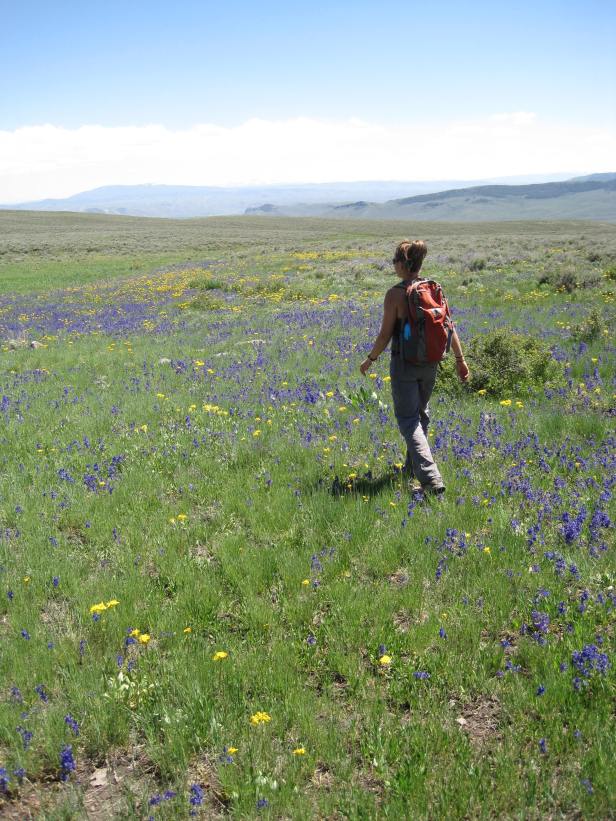Guest post by researcher Shawna Zimmerman
Linked paper: Evaluation of genetic change from translocation among Gunnison Sage-Grouse (Centrocercus minimus) populations by S.J. Zimmerman, C.L. Aldridge, A.D. Apa, and S.J. Oyler-McCance, The Condor: Ornithological Applications 121:1, February 2019.
Humans moving animals around for conservation?! This may not immediately sound like an action we should advocate for, but the purposeful movement of individuals from one place to another is often an effective way to give small, declining populations a boost in size or increase their genetic diversity. As human alteration of landscapes continues to fragment wildlife habitat and species distribution, this type of action is becoming increasingly common.
Despite their common use, the long-term effects of these purposeful movements, called “translocation,” are difficult to measure. One way to evaluate their impact is through genetic sampling—collecting genetic samples before individuals are moved between locations, and then comparing those data to genetic samples collected after individuals have been released in their new location and given some time to acclimate.
The Gunnison Sage-Grouse (Centrocercus mimimus) is a federally threatened bird species that persists as seven geographically separated populations, which are far enough apart that birds don’t frequently move between them. One population, located in the Gunnison Basin of Colorado, includes approximately 86% of the remaining individuals in the species, maintains a relatively stable population size from year to year, and is the most genetically diverse of all the populations. The six much smaller satellite populations have seen dramatic fluctuations in their population sizes and also have much lower genetic diversity.
Colorado Parks and Wildlife (CPW) were concerned about the viability of the satellite populations because of their small size and low genetic diversity, so in 2005 they began moving birds from the Gunnison Basin to four of the satellite populations. These efforts continued through 2014. While CPW was able to use radio collars to track some of the translocated individuals for a year, longer-term information on the fate of these individuals was lacking. Specifically, they were uncertain if these birds survived for more than a single year, or if they were integrating into the population and reproducing with the local birds. My co-authors and I set out to answer these two specific unknowns.

Genetic sampling can provide insight into both of these questions. Fortunately, we still had samples collected from all of the populations as part of a previous study done prior to translocation efforts, and we used these samples as our reference for change. In another stroke of luck, Gunnison Sage-Grouse have a lek mating system. This means birds gather in approximately the same location each spring to display and choose mates, leaving feathers behind. By visiting the mating sites to pick up these feathers, we could collect genetic samples without needing to disturb the birds. We collected feathers from leks predominantly between 2012 and 2014, and we used these samples to determine the current genetic state of the species.
To find out whether translocated birds were surviving, we first looked at the genetic diversity of each population and how different the individual populations are from each other, detecting some degree of change in all populations that received Gunnison Basin transplants. Looking at changes in genetic diversity at the individual level, we also found that individuals in populations that received Gunnison Basin transplants had increased genetic diversity which originated from Gunnison Basin, suggesting that translocated birds were reproducing.
Our results also showed that levels of genetic change varied among populations, indicating that the impacts of translocation differed from place to place. The two populations with the largest detected increase in genetic diversity also had a corresponding increase in population size, which indicates that translocation efforts may have had a particularly positive impact on these populations.
Our approach to evaluating translocation efforts in Gunnison Sage-Grouse was effective at detecting change that could be attributed to a conservation action, and the non-invasive sampling methods we used could be continued in the future if additional translocation efforts occur. The ability to evaluate the effects of conservation efforts non-invasively is particularly important for a species with federal protection, which makes other sampling approaches less feasible. The positive impact of translocation efforts increases hope for the persistence of the small satellite populations. However, if translocation efforts do not continue or natural dispersal among populations is not increased, observed gains in genetic diversity will ultimately be lost.
